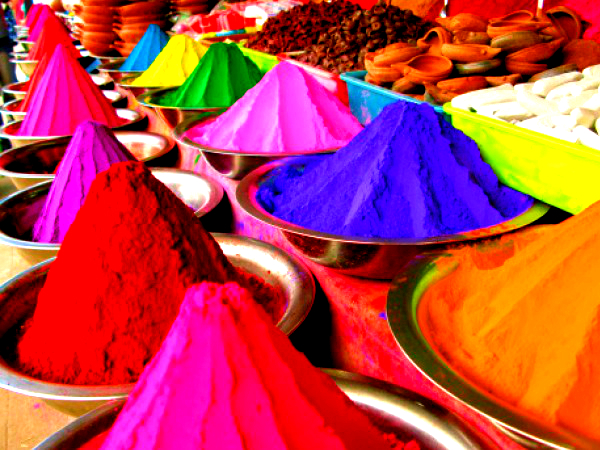Did you know that the gulaal you’re about to use on Holi is actually skin cancer-causing mercury sulphite? Read on.
 by Dr Ajaya Kashyap
by Dr Ajaya Kashyap
(Part I of III)
The festival of colours is back, and it is immersing people with much-needed joy and enthusiasm. Holi, the festival of colours, is among the most celebrated festivals in the Indian community.
However, be warned: most Holi colors sold in the market are oxidized metals or industrial dyes mixed with engine oil.
The green colour comes from a chemical known as copper sulphate, purple from chromium iodide, silver from aluminum bromide, black from lead oxide and other shiny colours are the result of powdered glass being added to the colours.
All these are toxic in nature and can result in anything from skin allergies to eye irritation and blindness, apart from many other disorders. When washed, they enter our rivers and the soil and increase pollution. So, everyone should play Holi safe as colours can lead to:
Lead Oxide (Black) leads to Renal failure, learning disability.
Copper Sulphate (Green) leads to eye allergy, temporary blindness.
Chromium Iodide (Purple) leads to Bronchial asthma, allergies.
Aluminium Bromide (Silver) is carcinogenic.
Mercury Sulphite (Red) leads to skin cancer.
I suggest you go for natural and eco-friendly colours. They are made from natural substances that are safe and soothing both for you and your environment. Though they are costlier, they are worth their price.
Over the years, the fad of chemical or artificial colours has become part of the festivity. These are prepared from harmful substances like acids, mica, glass powder and alkalis, and are quite capable of causing serious skin complications and allergies. Often referred to as unholy colours of Holi, artificial colours can lead to skin allergies, irritation, redness, rashes, itching and bumps on the skin.
Some of the allergies caused are:
Eczema One of the most common skin complications occurring due to effect of artificial colours. In this allergic condition, skin becomes scaly and appears to be inflamed. Besides, it has flaking and blisters that cause extreme itchiness.
Dermatitis Atopic dermatitis is another plausible allergy occurring due to chemical reaction of colours. The allergy causes severe itching, pain and blistering.
Rhinitis This allergic reaction is an inflammation of the nasal membrane, wherein one experiences nasal congestion, discharge, itching and sneezing.
Asthma Artificial colours can also cause severe damage to the airways, or developing asthma. In this allergic condition, one experiences breathing difficulty and shortness of breath.
Pneumonitis Another possible allergic condition occurring due to inhalation of chemically treated colours is pneumonitis, wherein one experiences fever, chest tightness, fatigue and breathing difficulty.
Dr Ajaya Kashyap is the Chief Surgeon, Cosmetic and Plastics, Fortis Hospital, Delhi.
Tomorrow: Caring for your hair and skin before playing Holi. Plus, how to make natural and herbal colours at home.






One Comment